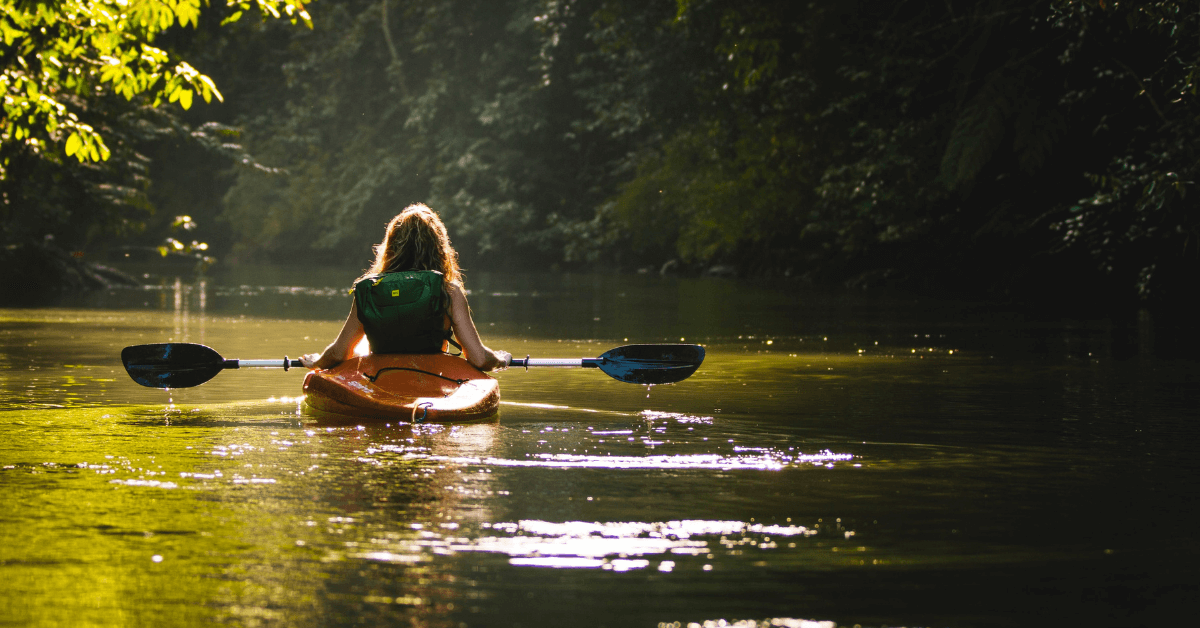Kayaking is a fun and adventurous way to explore the outdoors and stay fit. While kayaking is often thought of as a leisurely activity, long-distance kayaking requires proper training and preparation to ensure a safe and successful trip.
Plus, long-distance kayaking is not for the faint of heart. It requires physical and mental endurance, as well as a deep understanding of kayaking techniques and equipment. Proper training is essential for anyone looking to embark on a long-distance kayaking adventure – and that’s what we’ll discuss today.
Below, we’ll explore the various aspects of training for long-distance kayaking, including equipment, endurance building, technique development, trip planning, nutrition and hydration, and recovery and injury prevention.
By following the tips and advice in this guide, you can prepare yourself for a long-distance kayaking adventure of a lifetime. Let’s dive in!
Building Endurance for Long-Distance Kayaking
Endurance is a key factor in long distance kayaking. Without proper endurance, you may find yourself struggling to complete your journey, or worse, putting yourself at risk of injury or exhaustion. Building endurance takes time and dedication, but with the right training plan, you can prepare yourself for the physical demands of long distance kayaking. Here are some tips for building endurance for long distance kayaking:
1. Start slow and gradually increase distance
When building endurance for long distance kayaking, it’s important to start slow and gradually increase the distance you paddle over time. Begin with shorter paddles and gradually increase the duration and distance of your paddles as you become more comfortable and confident.
This will help prevent injury and allow your body to gradually adapt to the physical demands of long distance kayaking.
2. Incorporate cardiovascular exercises into your training
Cardiovascular exercises are essential for building endurance. Activities like running, cycling, or swimming can help improve your cardiovascular fitness and endurance, which will translate to better performance on the water. Aim for at least 30 minutes of cardiovascular exercise, three to five times per week.
3. Strength training for paddling
Paddling requires a lot of upper body strength, particularly in the shoulders, arms, and core. Incorporating strength training exercises into your training plan can help build the strength and endurance needed for long distance kayaking.
Focus on exercises like push-ups, pull-ups, planks, and rows, and aim for two to three strength training sessions per week.
4. Cross-training for kayaking
Cross-training can help build overall fitness and endurance, while also preventing overuse injuries. Activities like yoga, Pilates, or hiking can help improve your balance, flexibility, and core strength, which are all important for long distance kayaking. Aim for one to two cross-training sessions per week.
5. Take rest days and recovery seriously
Rest and recovery are just as important as training itself. Make sure to give your body time to rest and recover between training sessions. Incorporate rest days into your training plan, and prioritize sleep, hydration, and nutrition to help your body recover and rebuild between workouts.
Remember to take it slow, be consistent with your training, and listen to your body to avoid injury or burnout.
Related: The Best Exercises For Getting In And Out Of A Kayak
Developing Proper Technique for Long Distance Kayaking
Proper technique is essential for long distance kayaking, as it not only improves your efficiency on the water but also helps prevent injury and fatigue. Developing proper technique takes practice and patience, but with the right guidance and training, you can master the skills needed to become a proficient long distance kayaker.
Here are some tips for developing proper technique for long distance kayaking:
1. Master the basic paddle stroke
The basic paddle stroke is the foundation of kayaking technique. It involves using your core, arms, and shoulders to pull the paddle through the water, propelling your kayak forward. To master the basic paddle stroke, start by sitting upright in your kayak, with your feet placed firmly on the footrests.
Hold the paddle with a loose grip, and start by dipping the blade of the paddle into the water, keeping your elbows straight. Then, pull the blade towards your hip, using your core and arms to generate power. Repeat on the other side, alternating strokes as you paddle forward.
2. Practice efficient body positioning
Efficient body positioning can help improve your efficiency and reduce fatigue while paddling. Keep your back straight and your core engaged while paddling, and avoid slouching or hunching over the paddle. Position your feet on the footrests for stability and leverage, and keep your knees slightly bent to absorb shock and maintain balance.
3. Use proper kayak control techniques
Proper kayak control techniques can help you navigate through rough waters and challenging conditions with ease. Practice using your hips and body weight to steer your kayak, rather than relying solely on your paddle strokes.
Use your body weight to tilt your kayak to one side or the other, and use your paddle strokes to adjust your course and maintain balance.
4. Train with a professional or experienced kayaker
Training with a professional or experienced kayaker can help you refine your technique and improve your skills. They can provide guidance on proper technique, offer tips for improving your performance, and help you develop good habits and form.
5. Focus on consistency and repetition
Developing proper techniques takes time and repetition. Focus on practicing your technique consistently, and repeat the basic paddle stroke and other techniques regularly to build muscle memory and improve your proficiency.
Nutrition and Hydration for Long-Distance Kayaking

Long distance kayaking requires a significant amount of energy and endurance, making proper nutrition and hydration essential for success. Without proper fuel and hydration, kayakers are at risk of fatigue, dehydration, and even injury. Here are some tips for ensuring proper nutrition and hydration for long distance kayaking:
1. Plan and pack nutritious snacks and meals
Kayakers should plan ahead and pack nutritious snacks and meals to sustain them during long paddles. Good options include high-protein snacks like nuts and jerky, energy bars, and whole foods like fruits, vegetables, and whole grains.
Avoid packing foods that are high in sugar or processed, as these can cause energy crashes and hinder performance.
2. Stay hydrated
Staying hydrated is essential for long distance kayaking, as dehydration can lead to fatigue, cramping, and decreased performance. Kayakers should aim to drink water regularly throughout their paddles, and pack extra water or a hydration system to ensure they have enough to last the entire trip.
It’s also important to drink before you get thirsty, as thirst is a sign that you are already dehydrated.
3. Monitor electrolyte levels
Electrolytes, such as sodium and potassium, are essential for proper hydration and muscle function. Kayakers should monitor their electrolyte levels during long paddles and consider packing electrolyte-rich drinks or supplements to replenish their stores.
4. Consider caffeine and stimulants
Caffeine and other stimulants can provide a temporary boost of energy and focus, making them a popular choice among long distance kayakers. However, it’s important to use these substances in moderation and consider the potential side effects, such as increased heart rate and dehydration.
5. Replenish after the paddle
Proper nutrition and hydration don’t stop once the paddling is over. Kayakers should replenish their energy and hydration stores with nutritious foods and plenty of water after the paddle. Good options include high-protein meals, electrolyte-rich drinks, and plenty of water.
Remember to plan ahead, monitor your intake, and replenish regularly to stay fueled and hydrated.
Recovery and Injury Prevention for Long Distance Kayaking
Long distance kayaking can take a toll on the body, making proper recovery and injury prevention critical for staying healthy and performing at your best. Here are some tips for effective recovery and injury prevention for long distance kayaking:
1. Stretching and Warm-up
Before starting your long distance kayaking trip, it’s important to do some stretching and warm-up exercises. This helps to prevent injuries and prepares your body for the demands of kayaking. Some good warm-up exercises include light jogging, jumping jacks, and stretching your arms, shoulders, and back.
2. Proper Technique
Proper technique is important for preventing injuries and minimizing strain on the body during long distance kayaking. Kayakers should focus on maintaining a good posture, engaging their core muscles, and using their legs to power their strokes, rather than just relying on their upper body.
3. Rest and Recovery
Taking regular breaks and allowing your body time to rest and recover is essential for preventing injuries and avoiding burnout. If possible, aim to take a break every hour or so to stretch, hydrate, and rest your muscles.
4. Cross-Training
Incorporating cross-training exercises into your routine can help prevent overuse injuries and build strength in key muscle groups used during kayaking. Good options include swimming, cycling, and yoga.
5. Proper Nutrition
Proper nutrition is critical for effective recovery and injury prevention. Make sure to consume a balanced diet with plenty of protein and complex carbohydrates to help your muscles recover and rebuild.
6. Injury Treatment
In the unfortunate event of an injury, it’s important to address it promptly to prevent it from worsening. Ice the affected area, rest it, and seek medical attention if necessary.
Final Thoughts – Traning for Long Distance Kayaking
Training for long distance kayaking involves building endurance through consistent paddling, developing proper technique to improve efficiency and prevent injury, fueling your body with proper nutrition and hydration, and focusing on recovery to prevent burnout and maintain performance. Gradually increasing your distance and incorporating strength and flexibility exercises can help improve your performance and enjoyment of the activity.
By following these tips, you’ll be able to improve your long distance kayaking performance, prevent injuries, and have a more enjoyable and fulfilling experience on the water. So get out there, explore new waterways, and have fun kayaking!
